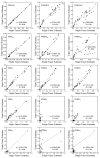Rapid Multi-Tracer PET Tumor Imaging With F-FDG and Secondary Shorter-Lived Tracers
- PMID: 20046800
- PMCID: PMC2799294
- DOI: 10.1109/TNS.2009.2026417
Rapid Multi-Tracer PET Tumor Imaging With F-FDG and Secondary Shorter-Lived Tracers
Abstract
Rapid multi-tracer PET, where two to three PET tracers are rapidly scanned with staggered injections, can recover certain imaging measures for each tracer based on differences in tracer kinetics and decay. We previously showed that single-tracer imaging measures can be recovered to a certain extent from rapid dual-tracer (62)Cu - PTSM (blood flow) + (62)Cu - ATSM (hypoxia) tumor imaging. In this work, the feasibility of rapidly imaging (18)F-FDG plus one or two of these shorter-lived secondary tracers was evaluated in the same tumor model. Dynamic PET imaging was performed in four dogs with pre-existing tumors, and the raw scan data was combined to emulate 60 minute long dual- and triple-tracer scans, using the single-tracer scans as gold standards. The multi-tracer data were processed for static (SUV) and kinetic (K(1), K(net)) endpoints for each tracer, followed by linear regression analysis of multi-tracer versus single-tracer results. Static and quantitative dynamic imaging measures of FDG were both accurately recovered from the multi-tracer scans, closely matching the single-tracer FDG standards (R > 0.99). Quantitative blood flow information, as measured by PTSM K(1) and SUV, was also accurately recovered from the multi-tracer scans (R = 0.97). Recovery of ATSM kinetic parameters proved more difficult, though the ATSM SUV was reasonably well recovered (R = 0.92). We conclude that certain additional information from one to two shorter-lived PET tracers may be measured in a rapid multi-tracer scan alongside FDG without compromising the assessment of glucose metabolism. Such additional and complementary information has the potential to improve tumor characterization in vivo, warranting further investigation of rapid multi-tracer techniques.
Figures








Similar articles
-
Methodology for quantitative rapid multi-tracer PET tumor characterizations.Theranostics. 2013 Oct 4;3(10):757-73. doi: 10.7150/thno.5201. Theranostics. 2013. PMID: 24312149 Free PMC article. Review.
-
Evaluation of rapid dual-tracer (62)Cu-PTSM + (62)Cu-ATSM PET in dogs with spontaneously occurring tumors.Phys Med Biol. 2008 Jan 7;53(1):217-32. doi: 10.1088/0031-9155/53/1/015. Epub 2007 Dec 19. Phys Med Biol. 2008. PMID: 18182698 Free PMC article.
-
Single-scan dual-tracer FLT+FDG PET tumor characterization.Phys Med Biol. 2013 Feb 7;58(3):429-49. doi: 10.1088/0031-9155/58/3/429. Epub 2013 Jan 8. Phys Med Biol. 2013. PMID: 23296314 Free PMC article.
-
Rapid dual-tracer PTSM+ATSM PET imaging of tumour blood flow and hypoxia: a simulation study.Phys Med Biol. 2006 Jan 7;51(1):61-75. doi: 10.1088/0031-9155/51/1/005. Epub 2005 Dec 15. Phys Med Biol. 2006. PMID: 16357431
-
Clinical Explorations of [68Ga] Ga-FAPI-04 and [18F] FDG Dual-Tracer Total-body PET/CT and PET/MR Imaging.Semin Nucl Med. 2024 Nov;54(6):904-913. doi: 10.1053/j.semnuclmed.2024.09.009. Epub 2024 Nov 2. Semin Nucl Med. 2024. PMID: 39489646 Review.
Cited by
-
Methodology for quantitative rapid multi-tracer PET tumor characterizations.Theranostics. 2013 Oct 4;3(10):757-73. doi: 10.7150/thno.5201. Theranostics. 2013. PMID: 24312149 Free PMC article. Review.
-
Signal separation of simultaneous dual-tracer PET imaging based on global spatial information and channel attention.EJNMMI Phys. 2024 May 29;11(1):47. doi: 10.1186/s40658-024-00649-9. EJNMMI Phys. 2024. PMID: 38809438 Free PMC article.
-
Kinetic model-informed deep learning for multiplexed PET image separation.EJNMMI Phys. 2024 Jul 1;11(1):56. doi: 10.1186/s40658-024-00660-0. EJNMMI Phys. 2024. PMID: 38951271 Free PMC article.
-
Evaluation of rapid dual-tracer (62)Cu-PTSM + (62)Cu-ATSM PET in dogs with spontaneously occurring tumors.Phys Med Biol. 2008 Jan 7;53(1):217-32. doi: 10.1088/0031-9155/53/1/015. Epub 2007 Dec 19. Phys Med Biol. 2008. PMID: 18182698 Free PMC article.
-
Kinetic modeling in PET imaging of hypoxia.Am J Nucl Med Mol Imaging. 2014 Sep 6;4(6):490-506. eCollection 2014. Am J Nucl Med Mol Imaging. 2014. PMID: 25250200 Free PMC article. Review.
References
-
- Huang SC, Carson RE, Hoffman EJ, Kuhl DE, Phelps ME. An investigation of a double-tracer technique for positron computerized tomography. J Nucl Med. 1982;23:816–822. - PubMed
-
- Ikoma Y, Toyama H, Uemura K, Uchiyama A. Evaluation of the reliability in kinetic analysis for dual tracer injection of FDG and flumazenil PET study. In: Seibert JA, editor. Conf Rec IEEE Nuc Sci Symp and Med Imaging Conf.; Piscataway, NJ, USA: 2001. IEEE.
-
- Koeppe RA, Ficaro EP, Raffel DM, Minoshima S, Kilbourn MR. Temporally overlapping dual-tracer PET studies. In: Carson RE, Daube-Witherspoon ME, Herscovitch P, editors. Quantitative Functional Brain Imaging With Positron Emission Tomography. San Diego, CA: Academic Press; 1998.
-
- Koeppe RA, Raffel DM, Snyder SE, Ficaro EP, Kilbourn MR, Kuhl DE. Dual-[11C]tracer single-acquisition positron emission tomography studies. J Cereb Blood Flow Metab. 2001;21:1480–1492. - PubMed
Grants and funding
LinkOut - more resources
Full Text Sources
Other Literature Sources
